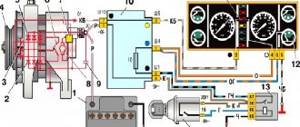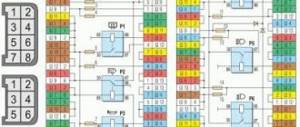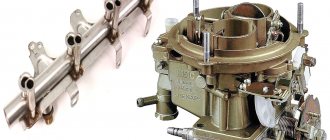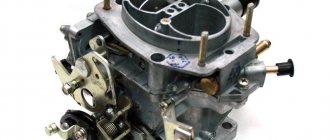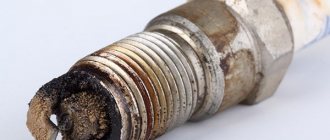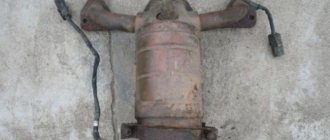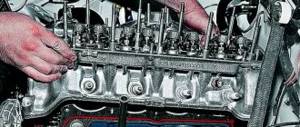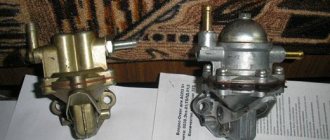Carburetor Features
The carburetor system is simpler in design and easier to maintain. An experienced motorist can independently repair its components: the carburetor and mechanical fuel pump. Repair kits for mounted units of domestic engines can be purchased at any car market and in most auto parts stores. In order to remove any of these components and replace failed parts, all you need is a simple tool, care and a little time.
The most difficult procedure in servicing a VAZ carburetor is adjusting the float and jets. This requires some experience. Adjustment of this unit is required not only after repairs and scheduled maintenance, but also quite often during operation, which causes additional trouble for car owners. However, from the point of view of most drivers, the main thing that distinguishes a carburetor from an injector is the ability to repair it yourself in any wilderness. In fact, it doesn’t matter what the engine thrust and fuel consumption will be if there is a breakdown on a trip - the main thing is to get to civilization, where you can get the necessary help.
Composition of the injection system
The engine fuel injection system is technically more advanced and reliable. But the presence of a larger number of components, their complexity and dependence on each other, complicate diagnostics and independent repairs, especially on the road.
It includes:
- electric fuel pump;
- distribution ramp;
- injectors (nozzles);
- electronic control unit;
- a group of sensors (throttle position, lambda probe, air flow, detonation).
The electronic injection control unit on VAZ cars also uses signals from sensors that are also present on a carburetor engine, for example, temperature, hall, etc. It’s just that in an engine with a carburetor, the functionality of these devices is no longer related to the fuel supply.
Injection present
Fuel injection took the automotive market by storm in the 1980s by injecting gasoline into the intake manifold or directly into the combustion chamber. Actually, injection is carried out by special nozzles, which are popularly called injectors. Most often, modern designs use distributed and direct injection. The system operates based on sensors:
- detonation;
- oxygen content in exhaust gases;
- mass air flow;
- position, crankshaft rotation speed;
- throttle position;
- incoming air temperature;
- voltage in the on-board network;
- car speed, etc.
The injector is considered more reliable if refueled with normal gasoline
It’s easy to guess that this is a great progress in comparison with carburetor counterparts, but there is a catch here. After all, the more components and parts, the greater the likelihood of feeling the consequences of a system breakdown.
However, an injection engine is considered more reliable if you refuel with normal gasoline and follow the manufacturer’s operating recommendations.
For example, the electronic control unit independently monitors the moment of sparking. This reduces the risk of valve burnout due to late ignition and high-octane gasoline. The accuracy of the mixture composition is guaranteed by the Lambda sensor.
As a result, when the injector operates, significantly less soot and deposits accumulate in the combustion chamber. The tendency to detonation from low-quality fuel is also suppressed, which can cause destruction of pistons and partitions between the rings.
A carburetor engine reacts worse to changes in wheel load and consumes more fuel.
The operation of the carburetor is much simpler, the proportions are prepared approximately, and also do not change depending on the situation, which is why there is a lack of stability. A carburetor engine reacts worse to changes in the load on the wheels; it consumes more fuel in situations where the injection system itself temporarily stops supplying the working mixture.
The carburetor settings are static; the unit must be configured independently; it does not provide flexible operating algorithms.
At the same time, both the carburetor system and injection allow for tuning. You can upload special firmware to the ECU, which will change the system settings, focusing, say, on dynamic performance. In the same way, it is possible to adjust the carburetor, and it will produce an average consumption of 6.5 l/100 km. But the main reason for the world community’s refusal of the carburetor was the introduction of stricter engine toxicity standards.
Injection engines are more environmentally friendly; for hundreds of thousands of kilometers they keep emissions within the legal limits of air pollution.
Carburetor models never managed to rise above Euro-1 standards, which sealed their fate in the near future.
Technological features in operation
The technological difference between a carburetor and an injector lies in the method of supplying fuel to the combustion chambers. In a carburetor system, fuel is delivered to the cylinders using the suction principle. The piston, moving on the intake stroke, creates a vacuum in the cylinder and draws the air-fuel mixture through the intake manifold from the carburetor. Carburetor adjustment is responsible for the quality of the mixture. The main drawback is that the quality of the fuel mixture is the same in all engine operating modes, with the exception of choke during warm-up mode.
In an injection system, fuel is injected under pressure either into the intake manifold or directly into the engine cylinders, forming an air-fuel mixture at the time of injection. The fuel is clearly dosed by an electronic control system depending on the mode and operating conditions of the power unit. Moreover, the control unit adjusts injection and ignition timing. Together, this results in increased power, increased torque and fuel savings. Simply put, the car becomes more responsive and faster with less fuel consumption.
You can feel the difference between carburete and injector on Niva cars very clearly. With almost identical performance indicators declared by the manufacturer, in practice the injection Niva is more playful and responsive. And if fuel consumption when driving on a flat road differs slightly (up to 0.5 liters), then when driving on mountain or dirt roads the gap increases significantly. But this car is an SUV.
Another undoubted advantage of an injection engine is the stability of its operation. System adjustment is rarely required. All its components have a long service life and are quite reliable.
However, the injector has its own disadvantages:
- higher cost of maintenance and components for repair;
- special equipment is required for diagnostics, repairs and equipment, which narrows the independent capabilities of the car enthusiast;
- more complex diagnostics;
- When driving frequently with a small amount of gasoline in the tank, the submersible fuel pump fails.
As factory equipped with an injector, VAZ cars are equipped with submersible electric fuel pumps in the tank.
Such pumps are cooled by gasoline, and when the tank is almost empty, they overheat and fail. The first sign of a pump malfunction is its louder operation (humming). To avoid overheating of the electric fuel pump, drivers have to constantly maintain a certain minimum level of fuel in the tank, thus reducing its operating volume. When installing injectors on a VAZ themselves, some craftsmen use an externally installed electric fuel pump. In practice, this option is no better than the previous one: it is more difficult to fill the system if you reach an empty tank. And if you pump gasoline with a “dry” electric pump, it will quickly become unusable.
What is better - a carburetor or an injector and how they differ
Over the past decade, debates have arisen among fans of VAZ cars about which petrol engine power supply system is better. In order to decide which is preferable, a carburetor or an injector, you should understand the differences in their design and operation.
Carburetor Features
The carburetor system is simpler in design and easier to maintain. An experienced motorist can independently repair its components: the carburetor and mechanical fuel pump. Repair kits for mounted units of domestic engines can be purchased at any car market and in most auto parts stores. In order to remove any of these components and replace failed parts, all you need is a simple tool, care and a little time.
The most difficult procedure in servicing a VAZ carburetor is adjusting the float and jets. This requires some experience. Adjustment of this unit is required not only after repairs and scheduled maintenance, but also quite often during operation, which causes additional trouble for car owners. However, from the point of view of most drivers, the main thing that distinguishes a carburetor from an injector is the ability to repair it yourself in any wilderness. In fact, it doesn’t matter what the engine thrust and fuel consumption will be if there is a breakdown on a trip - the main thing is to get to civilization, where you can get the necessary help.
Composition of the injection system
The engine fuel injection system is technically more advanced and reliable. But the presence of a larger number of components, their complexity and dependence on each other, complicate diagnostics and independent repairs, especially on the road.
It includes:
- electric fuel pump;
- distribution ramp;
- injectors (nozzles);
- electronic control unit;
- a group of sensors (throttle position, lambda probe, air flow, detonation).
The electronic injection control unit on VAZ cars also uses signals from sensors that are also present on a carburetor engine, for example, temperature, hall, etc. It’s just that in an engine with a carburetor, the functionality of these devices is no longer related to the fuel supply.
Technological features in operation
The technological difference between a carburetor and an injector lies in the method of supplying fuel to the combustion chambers. In a carburetor system, fuel is delivered to the cylinders using the suction principle. The piston, moving on the intake stroke, creates a vacuum in the cylinder and draws the air-fuel mixture through the intake manifold from the carburetor. Carburetor adjustment is responsible for the quality of the mixture. The main drawback is that the quality of the fuel mixture is the same in all engine operating modes, with the exception of choke during warm-up mode.
In an injection system, fuel is injected under pressure either into the intake manifold or directly into the engine cylinders, forming an air-fuel mixture at the time of injection. The fuel is clearly dosed by an electronic control system depending on the mode and operating conditions of the power unit. Moreover, the control unit adjusts injection and ignition timing. Together, this results in increased power, increased torque and fuel savings. Simply put, the car becomes more responsive and faster with less fuel consumption.
You can feel the difference between carburete and injector on Niva cars very clearly. With almost identical performance indicators declared by the manufacturer, in practice the injection Niva is more playful and responsive. And if fuel consumption when driving on a flat road differs slightly (up to 0.5 liters), then when driving on mountain or dirt roads the gap increases significantly. But this car is an SUV.
Another undoubted advantage of an injection engine is the stability of its operation. System adjustment is rarely required. All its components have a long service life and are quite reliable.
However, the injector has its own disadvantages:
- higher cost of maintenance and components for repair;
- special equipment is required for diagnostics, repairs and equipment, which narrows the independent capabilities of the car enthusiast;
- more complex diagnostics;
- When driving frequently with a small amount of gasoline in the tank, the submersible fuel pump fails.
As factory equipped with an injector, VAZ cars are equipped with submersible electric fuel pumps in the tank. Such pumps are cooled by gasoline, and when the tank is almost empty, they overheat and fail. The first sign of a pump malfunction is its louder operation (humming). To avoid overheating of the electric fuel pump, drivers have to constantly maintain a certain minimum level of fuel in the tank, thus reducing its operating volume.
When installing injectors on a VAZ themselves, some craftsmen use an externally installed electric fuel pump. In practice, this option is no better than the previous one: it is more difficult to fill the system if you reach an empty tank. And if you pump gasoline with a “dry” electric pump, it will quickly become unusable.
Nuances of injector diagnostics
The difficulty of diagnosing a VAZ injection system lies in the fact that its operation is affected by all components and it is not so easy to understand what exactly is malfunctioning:
- nozzle;
- any sensor;
- pressure regulator;
- Control block.
The catch may lie in the fuel pump: the mere presence of fuel in the rail is not a sufficient condition for the injector to operate - it is necessary that the pump provide a certain performance and pressure. Check the indicated indicators using a volumetric flask and a pressure gauge.
Unlike a carburetor, the quality of operation of the injection system is influenced by the condition of the vehicle's electrical wiring. Oxidized wiring connectors and sensors can cause failures. And if instead of 12V only 8V reaches the terminals of the electric pump, then there can be no talk of any of its performance, and therefore normal operation of the engine.
The influence of gasoline quality on fuel systems
Both injection and carburetor engines are sensitive to the quality of gasoline. Quite often, after refueling with gasoline of a different quality (either worse or better), owners of carburetor cars turn to a specialist for adjustment. Returning to fuel of the same quality again entails adjustment.
For an engine equipped with an injector, the control unit, receiving information from sensors, independently adjusts the fuel supply. The driver, of course, can feel a change in engine thrust or notice fluctuations in fuel consumption, but this will not disrupt his planned trips. So, from the point of view of the quality of the fuel being filled, an injector is better than a carburetor (an outright surrogate does not count, because it will ruin any engine).
Is it worth converting a carburetor car to an injection car?
Thinking about what is better, a carburetor or an injector, some owners of VAZ cars are thinking about converting their vehicles. Models 2107 and 2109 are most often converted. It is important to understand the driver’s motive here. If the purpose of re-equipment is to save money, then this is a utopia. When purchasing a fuel-injected car, its cost does not differ significantly from that of a carburetor.
Independent re-equipment will cost a pretty penny, since you need to buy more than 50 very expensive system elements. For all this you need to pay a lot and immediately. And the car will save a little bit over a long period. Depending on who drives how much, the payback period may not come very soon, or may not come at all.
But if the motive for the conversion is the desire to get a more dynamic and reliable car at any time of the year, especially one used in densely populated areas, then it’s worth it. On busy city streets, the carburetor VAZ 2109 is inferior in maneuverability to its injection counterpart. In winter, while the weakly heated carburetor starts moving at a traffic light, the fuel-injected car will already be at the next intersection.
Summing up
Carburetor engines remain preferred where car service is not available. And then, with a caveat: it is unlikely that in thirty-degree frost anyone will be able to repair the carburetor. At this air temperature, a fuel-injected car has a better chance of starting. Therefore, the choice is in favor of an injector.
ZnanieAvto.ru
Nuances of injector diagnostics
The difficulty of diagnosing a VAZ injection system lies in the fact that its operation is affected by all components and it is not so easy to understand what exactly is malfunctioning:
- nozzle;
- any sensor;
- pressure regulator;
- Control block.
The catch may lie in the fuel pump: the mere presence of fuel in the rail is not a sufficient condition for the injector to operate - it is necessary that the pump provide a certain performance and pressure. Check the indicated indicators using a volumetric flask and a pressure gauge.
Unlike a carburetor, the quality of operation of the injection system is influenced by the condition of the vehicle's electrical wiring. Oxidized wiring connectors and sensors can cause failures. And if instead of 12V only 8V reaches the terminals of the electric pump, then there can be no talk of any of its performance, and therefore normal operation of the engine.
The principle of operation of the injector and carburetor
The main difference between an injection engine and a carburetor engine is the technology for supplying air and fuel to the engine. from The carburetor creates an air-fuel mixture and regulates its flow; the combustible fuel-air mixture is sucked into the engine due to the difference in pressure between the atmosphere and the intake manifold.
The injector is a modern electronic fuel supply system. In it, the composition of the air-fuel mixture is regulated by an electronic system. Fuel is injected into the air stream using special nozzles. The combustible mixture is injected into the combustion chamber and enters the engine cylinders. Most modern cars are equipped with injectors due to the advantages described below.
The influence of gasoline quality on fuel systems
Both injection and carburetor engines are sensitive to the quality of gasoline. Quite often, after refueling with gasoline of a different quality (either worse or better), owners of carburetor cars turn to a specialist for adjustment. Returning to fuel of the same quality again entails adjustment.
For an engine equipped with an injector, the control unit, receiving information from sensors, independently adjusts the fuel supply. The driver, of course, can feel a change in engine thrust or notice fluctuations in fuel consumption, but this will not disrupt his planned trips. So, from the point of view of the quality of the fuel being filled, an injector is better than a carburetor (an outright surrogate does not count, because it will ruin any engine).
Pros and cons of injection engines
Injection engine design
The power of an injection engine can increase by 10% compared to that of a carburetor. A special method of fuel injection, precise setting of the ignition angle, design of the intake manifold - all these factors contribute to an increase in power.
In addition, injection systems are more economical than carburetor systems. Electronics regulate the amount of gasoline depending on engine speed. Thanks to the precise operation of the control unit, fewer toxic substances enter the exhaust gases, because the fuel burns without residue.
It is easier to start an injection engine in winter, because it does not need to be warmed up, the system works automatically and does not depend on the ambient temperature. Most injection engines are very reliable. Their design does not include a distributor, which often breaks on carburetor cars.
The disadvantages of the injector include:
- difficulty of diagnosis and repair;
- high sensitivity to gasoline quality;
- high cost of spare parts.
Although cars with injection engines dominate the market, even they are not without their drawbacks.
Is it worth converting a carburetor car to an injection car?
Thinking about what is better, a carburetor or an injector, some owners of VAZ cars are thinking about converting their vehicles. Models 2107 and 2109 are most often converted. It is important to understand the driver’s motive here. If the purpose of re-equipment is to save money, then this is a utopia. When purchasing a fuel-injected car, its cost does not differ significantly from that of a carburetor.
Independent re-equipment will cost a pretty penny, since you need to buy more than 50 very expensive system elements. For all this you need to pay a lot and immediately. And the car will save a little bit over a long period. Depending on who drives how much, the payback period may not come very soon, or may not come at all.
But if the motive for the conversion is the desire to get a more dynamic and reliable car at any time of the year, especially one used in densely populated areas, then it’s worth it. On busy city streets, the carburetor VAZ 2109 is inferior in maneuverability to its injection counterpart. In winter, while the weakly heated carburetor starts moving at a traffic light, the fuel-injected car will already be at the next intersection.
